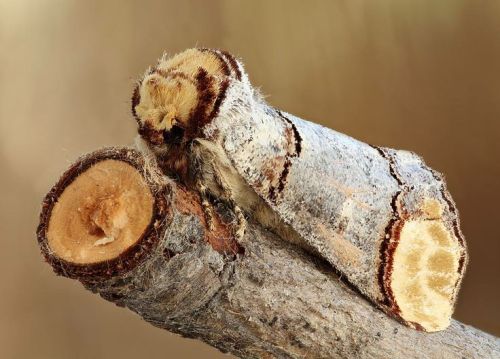Notodontidae - Tumblr Posts
Moth of the Week
Buff-Tip
Phalera bucephala

The buff-tip is part of the family Notodontidae and was first described in 1758 by Carl Linnaeus. They are best know for their resemblance of a broken birch twig when at rest. The name buff-tip comes from the color on the head and edge of the wings, buff: “a light brownish yellow, ochreous colour, typical of buff leather.”
Description The body is hairy, with a buff colored patch on the head followed by a brown ring. The upper body visible from under the wings is a mottled gray to match the forewings. The rest of the body is covered when resting and is a cream white with gray, cream and or brown legs. The forewings are also mottled gray with brown patterning and a buff patch at the tip mirrored on both sides. The hindwings are the same cream as the lower body. The antennae are brown and hidden when camouflaged.
Average wingspan: 55-68 mm
Males are smaller than females
Diet and Habitat Common food plants for this moth include the Norway maple, birch, chestnut, hazel, oak and many more. Caterpillars are social as young larva and eat in groups which can cause the defoliation of their host plants. Adult moths do not feed.
This moth is found across Europe and in Asia to eastern Siberia. It is very common in the British Isles, more so in the south than in the north. They prefer habitats with deciduous trees like open woodlands, scrubs, hedgerows, and urban gardens.
Mating Generally, the buff-tip can be seen from May to July, which is most likely their mating season. This moth is strictly nocturnal so it is also most likely they mate during the night. They have one generation per year with the females laying the eggs in clusters on the underside of leaves. The young larva are sociable and grow to be solitary through 4 instars.
Predators In order to protect itself while resting during the day, this species has adapted to look like a broken birch twig. This deceives common day time predators of moths such as birds and lizards.
Fun Fact This moth has been considered a pest in Lithuania for eating apple trees in the 1900s. High levels of environmental nitrogen compounds can increase outbreaks of the buff-tip.
(Source: Wikipedia, Wildlife Insight, London Wildlife Trust, Butterfly Conservation)